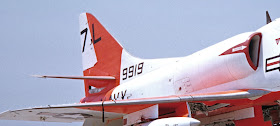16 January 2017: Bill Gilman noted (see his comment below) that the later canopy seemed to be more bulged laterally. I had wondered about this in passing but hadn't taken a close look at it. However, it's obvious, certainly the shape of the frames between the windscreen and sliding canopy.
I'm not sure that the later sliding canopy is bulged more laterally very far aft of its bow. The color picture on the right was taken by Don Hinton of the F2H-2P at the National Naval Aviation Museum in Pensacola. A set of his pictures is available at Phil's Aeronautical Stuff here:
http://www.philsaeronauticalstuff.com/f2h-2p/f2h-2p.html
There were two different F2H Banshee canopies, not counting the one on the original XF2D-1 prototypes.
It had a shorter sliding section and a somewhat different windscreen, particularly its forward interface with the fuselage. Note also that Bob Edholm is testing an XF2D without the benefit of an ejection seat.
For some reason, after completion of F2H-1 production and not quite half of the F2H-2s, McAir elected to produce the remainder, beginning with BuNo 124940, with a slightly different canopy. The center panel of the windscreen, which had been straight sided, was now an oval with heavier framing.
(The red post in the color picture on the left is the Davis barrier activator; it was spring-loaded to extend when the tailhook was lowered. It was stowed manually after landing as shown in the gray-scale photo on the right.)
I only have a McAir lines drawing for the later canopy.
The sliding canopy bow, which had had a flattened top, now had a smooth curve.
It appears to me that the center panel of the new windscreen was raised slightly, parallel to the original one, as evidenced by the steeper slope of the fairing at its front edge. It's possible that the change was to provide better visibility of the LSO on the approach to the carrier.
I don't know how many F2H-2s produced prior to BuNo 124940 were retrofitted. I do have photographs of two, both F2H-2Ns, BuNos 123300 and 123301, with the later canopy.
Note the unpainted sheet metal of the fuselage-skin change required.























